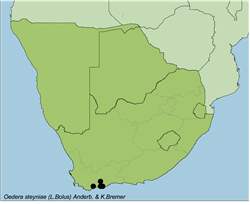Names and synonyms
Oedera steyniae (L.Bolus) Anderberg & Bremer
=Relhania steyniae L. Bolus
Type
Steyn, Herb. Galpin No. 5438, Still Bay (BOL, K, PRE).
Derivation of names
Oedera = after George Christian Oeder (1728-1791), professor of Botany in Copenhagen, author of Flora Danica
steyniae = after J.G. Steyn (around 1904), the collector of the type specimen.
Diagnostic characters
Stems very densely leafy
Lower parts of branches bare with distinct leaf scars
Leaves 4-ranked, giving an angular apearance to the stems
Leaves folded boat-shaped; midrib prominent and ending in a pungent tip
Leaves are longest in the mid-section of the leafy branch, shorter in lower part, about half the length just below the inflorescence.
Leaves indistincly gland-dotted
Capitula terminal in groups of 2-6
Description
A moderately branched, 0.3-1.5 m tall shrublet. Stems ascending-erect, tomentose, densely leafy, becoming glabrous and nude and marked with leaf-scars. Leaves decussate, in four distinct rows, spreading, carinate, lanceolate, 8-18 x 1.5-3.5 mm, glabrous but marginally pilose, acuminate, pungent. Capitula 3-9 together in dense terminal cymes. Peduncles very short or absent. Involucre cup-shaped, 5-9 x 3-6 mm. Involucral bracts 20-40, outer ovate, inner gradually narrower and oblong, innermost with a somewhat spreading, brown apical limb, dorsally gland-dotted, obtuse-rounded. Receptacle convex, paleate. Paleae canaliculate, linear, 5-7 x 0.5-1 mm, dorsally gland-dotted, acute. Ray florets 8-16, tube 2-2.5 mm long, densely glandular; lamina elliptic, 2.5-3.5 x 1-1.5 mm, 4-veined. Disc florets 25-40, perfect, corolla 3.5-5.3 mm long, tube densely glandular on upper half. Cypselas almost terete, narrowly oblong, 2-3 x 0.4-0.6 mm, glabrous. Pappus crownlike, of � connate scales, up to 0.8 mm long.
Flowering time
Mainly from July to September.
Distribution
Known from a few localities near the coast between Breede River and Gourits River.
Known from fewer than 20 specimens.
Habitat
Stony limestone, in crevices in shallow sand over limestone bedrock.
Notes
This species is a small shrub and not difficult to recognize with its characteristic foliage and congested capitula.
References
ANDERBERG, A.A. & BREMER, K. 1991. Parsimony analysis and cladistic reclassification of the Relhania generic group (Asteraceae - Gnaphalieae). Annals of the Missouri Botanical Garden 78: 1061-1072.
BREMER, K. 1976. The genus Relhania (Compositae). Opera Botanica 40.
GOLDBLATT, P. & MANNING, J.C. 2000. Cape Plants. A conspectus of the Cape flora of South Africa. Strelitzia 9. SANBI.
HARVEY. 1865. Compositae in: W.H. Harvey & O.W. Sonder. Flora Capensis 3 (ed. 1). Hodges & Smith, Dublin.
KESTING, D. & CLARKE, H. 2008. Botanical names, what they mean. Wild Flowers of the Cape Peninsula, 3rd revised edition. Friends of Silvermine.
PHILLIPS.1940. The Flowering Plants of South Africa 20: t. 786
SMITH, C. A. 1927. Four interesting species of Compositae. Bothalia 2: 360-365.
